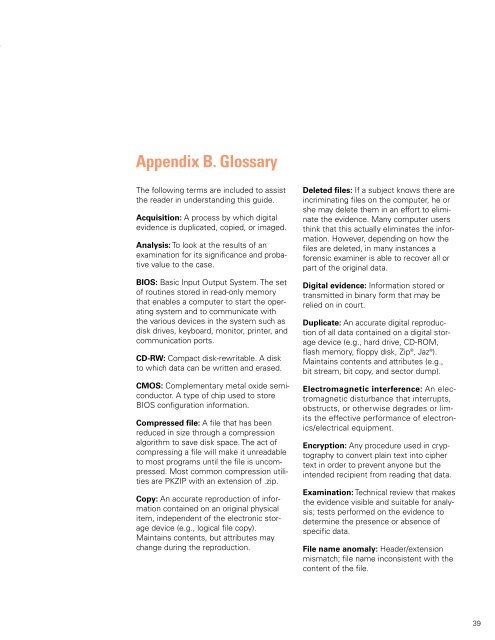Forensic Examination of Digital Evidence
Create successful ePaper yourself
Turn your PDF publications into a flip-book with our unique Google optimized e-Paper software.
Appendix B. Glossary<br />
The following terms are included to assist<br />
the reader in understanding this guide.<br />
Acquisition: A process by which digital<br />
evidence is duplicated, copied, or imaged.<br />
Analysis: To look at the results <strong>of</strong> an<br />
examination for its significance and probative<br />
value to the case.<br />
BIOS: Basic Input Output System. The set<br />
<strong>of</strong> routines stored in read-only memory<br />
that enables a computer to start the operating<br />
system and to communicate with<br />
the various devices in the system such as<br />
disk drives, keyboard, monitor, printer, and<br />
communication ports.<br />
CD-RW: Compact disk-rewritable. A disk<br />
to which data can be written and erased.<br />
CMOS: Complementary metal oxide semiconductor.<br />
A type <strong>of</strong> chip used to store<br />
BIOS configuration information.<br />
Compressed file: A file that has been<br />
reduced in size through a compression<br />
algorithm to save disk space. The act <strong>of</strong><br />
compressing a file will make it unreadable<br />
to most programs until the file is uncompressed.<br />
Most common compression utilities<br />
are PKZIP with an extension <strong>of</strong> .zip.<br />
Copy: An accurate reproduction <strong>of</strong> information<br />
contained on an original physical<br />
item, independent <strong>of</strong> the electronic storage<br />
device (e.g., logical file copy).<br />
Maintains contents, but attributes may<br />
change during the reproduction.<br />
Deleted files: If a subject knows there are<br />
incriminating files on the computer, he or<br />
she may delete them in an effort to eliminate<br />
the evidence. Many computer users<br />
think that this actually eliminates the information.<br />
However, depending on how the<br />
files are deleted, in many instances a<br />
forensic examiner is able to recover all or<br />
part <strong>of</strong> the original data.<br />
<strong>Digital</strong> evidence: Information stored or<br />
transmitted in binary form that may be<br />
relied on in court.<br />
Duplicate: An accurate digital reproduction<br />
<strong>of</strong> all data contained on a digital storage<br />
device (e.g., hard drive, CD-ROM,<br />
flash memory, floppy disk, Zip ® , Jaz ® ).<br />
Maintains contents and attributes (e.g.,<br />
bit stream, bit copy, and sector dump).<br />
Electromagnetic interference: An electromagnetic<br />
disturbance that interrupts,<br />
obstructs, or otherwise degrades or limits<br />
the effective performance <strong>of</strong> electronics/electrical<br />
equipment.<br />
Encryption: Any procedure used in cryptography<br />
to convert plain text into cipher<br />
text in order to prevent anyone but the<br />
intended recipient from reading that data.<br />
<strong>Examination</strong>: Technical review that makes<br />
the evidence visible and suitable for analysis;<br />
tests performed on the evidence to<br />
determine the presence or absence <strong>of</strong><br />
specific data.<br />
File name anomaly: Header/extension<br />
mismatch; file name inconsistent with the<br />
content <strong>of</strong> the file.<br />
39



